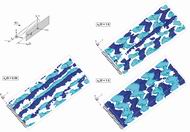You are here
Home ›Three-Dimensional Structure of Near-Wake of a Cylinder with a Helical Surface Perturbation
Three-Dimensional Structure of Near-Wake of a Cylinder with a Helical Surface Perturbation. Flow past a circular cylinder with a helical surface perturbation is represented in the layout of images. The perturbation is in the form of a small wire having a diameter nearly two orders of magnitude smaller than the cylinder diameter. The value of Reynolds number is 160. Patterns of instantaneous transverse velocity component v were acquired as a function of time at each given location xp of the plane of the laser sheet downstream of the cylinder of diameter D, i.e., xp/D = 0.56, 1.0 and 1.5, where xp is measured from the centerline of the cylinder. This time sequence of images is then stacked, and contours of constant v are constructed, in order to obtain a volume-type representation, as indicated in each of the three-dimensional images of the layout. At a location immediately adjacent to the base of the cylinder, xp/D = 0.56, the volumes approximate longitudinal tubes of positive (dark blue) and negative (light blue) velocity component v. At successively larger values of xp/D = 1.0 and 1.5, this structure transforms radically to volumes of v nominally oriented along the span of the cylinder, but exhibiting severe spanwise distortion. This transformation of three-dimensional patterns of v is accompanied by an analogous, fundamental transformation of volumes of vorticity ω with increasing xp/D (not shown). In essence, the transformation is due to the robust nature of the inherent three-dimensional instability mechanism of the near- wake, which overcomes the three-dimensional instability induced by the perturbation on the surface of the cylinder.
It is well known that the fluctuating lift and base pressure coefficients on a circular cylinder undergo large changes with increasing Reynolds number over the range extending approximately from 103 to 104. These variations of the loading, obtained in previous investigations, are physically interpreted herein with wholefield patterns of the flow structure. A central feature is the earlier onset of small-scale vortical structures in the separating shear layer with increasing Reynolds number. These structures substantially enhance the level of Reynolds stress correlation in the separating shear layer. In turn, it is demonstrated that this enhancement is associated with: the onset of pronounced cross-stream velocity, i.e., entrained flow into the shear layer, which is particularly evident in the base region at higher values of Reynolds number; and the onset of a negative pocket of streamwise velocity, which migrates upstream with increasing Reynolds number. The overall consequence of these alterations of the near-wake is a substantial decrease in formation length of the large-scale Kármán vortex, which is interpreted via patterns of phase-referenced instantaneous velocity and time-averaged vorticity.

